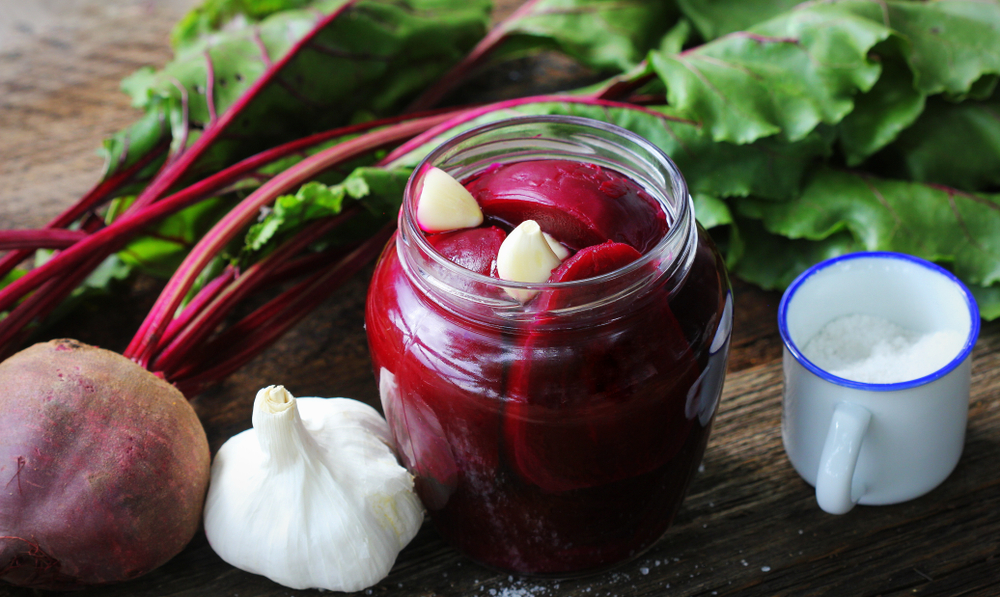
Now that it’s fall, it’s time to bask in the glory of all of the beets, carrots, cauliflower and cabbage that you’ve plucked out of the ground.
But whether you’re a seasoned grower or first-time gardener, you might have more food than you know what to do with. And some of your surplus veggies will likely end up in a compost bin or in the trash before you get the chance to eat them. A study conducted by nonprofit Ampleharvest.org found that up to 11.5 billion pounds of excess produce is wasted each year. The USDA estimates that 30 to 40 percent of our food supply ends up in a landfill.
One way to ensure you’re not contributing to this very large problem is by preserving your food. There are a number of methods like freezing, drying or dehydrating that are effective choices for extending the shelf life of your home-grown treasures for weeks, even months. Today we’re going to tackle a basic method of pickling.
In order to pickle your produce, you’ll need an acidic solution, such as vinegar or salt brine. We’ll walk you through a process that involves using a hot mixture of water, vinegar, sugar and whatever spices you have on hand—otherwise known as quick pickling.
What you’ll need
- Fresh vegetables of your choice
- High grade white vinegar or apple cider vinegar (5 percent acidity)
- Spices of your choice (the fresher, the better)
- Non iodized canning or pickling salt
- Brown or granulated sugar
- Mason jars
- A stainless steel cooking pot
Prepping your produce
Experts from University of Wisconsin Extension say for best results use produce that’s been harvested within the last 24 hours. If you aren’t able to pickle immediately, refrigerate your vegetables for no more than a few days.
Before you start slicing or peeling, it’s important to carefully wash your vegetables to get rid of any dirt on them. This can be a source of bacteria, which could cause your vegetables to soften during the pickling process. Areas around the stem will require special scrubbing attention.
You can now start peeling and chopping. Get rid of any blemishes or soft spots. Firmer vegetables, like beets or carrots, you might want to boil a bit before you pickle them so that the texture is softer for when it’s tasting time.
It’s really up to you on what you want your veggies to look like, but once you’ve sliced or cubed them to your liking, place them in a jar. We have a simple brine for you below and based on those measurements, you can use about 2.5 to 3 cups of vegetables.
*Note: You’ll want to sterilize your jars before you put your vegetables into them. You can do this by washing them in warm soapy water and then boiling them for 10 minutes. Keep them hot until it’s time to dump the vegetables in them.
Making your base
There are lots of ways to make your base depending on how sweet or salty you want your vegetables to be. The National Center for Home Food Preservation has a lot of different recipes. But if you want to start out simple and just make a basic brine, it would be safe to go with equal parts vinegar and water with a sixteenth of that amount in equal parts salt and sugar. See sample measurements below. This mixture is enough for vegetables that will fit into a half-gallon jar or roughly two-quart mason jars:
- 1 cup vinegar
- 1 cup water
- 1 tablespoon salt
- 1 tablespoon sugar
It’s important to use water with low levels of minerals and chlorine, known as soft water. If you’re unsure about the composition of your water, boil it for 15 minutes in a stainless steel pot and allow it to sit covered for 24 hours. It’s possible that there will be a coating on the surface of your water. Use a ladle to remove this.
When you have all your ingredients for the base, combine them into your stainless steel pot and bring to a boil for 10 minutes. Stir occasionally to ensure the salt and sugar dissolve.
Adding spice
While your brine is boiling, add your spices to the jars with your veggies. We recommend you use fresh spices (or at least ones that are not in powdered form). Powdered spices will cloud your mixture and they aren’t as strong in flavor.
There are a number of options you have for spices. A standard combination that pairs well with the base we’ve provided is whole black pepper corn, mustard seeds, coriander and dill.
Others you could choose from or add into the mix could consist of anything from bay leaves, cinnamon sticks, chilli peppers, fennel seeds, garlic cloves, fenugreek, turmeric, ginger, thyme, tarragon, basil, sage and tarragon. Put your own twist on your pickling creation.
Mixing it all together
Allow your brine solution to cool to a lukewarm temperature and pour it into your jars over the vegetables and the spices you have chosen. All the vegetables should be completely submerged. Fill each jar with this mixture and leave about half an inch of headspace from the lid.
You don’t want any air bubbles before you seal your jars shut. You can remove them with a spatula or other cooking utensil. At this point you can add an airtight lid. Be mindful of any remaining air bubbles. If you tap and wiggle the jars from left to right this will help get rid of them.
Let your jars cool to room temperature and then put them in the refrigerator. Wait at least 48 hours before tasting the final product. You can typically keep quick pickled produce in your fridge for two to three months before it will start to go bad.
October 11, 2020 at 08:00PM
https://ift.tt/2SOmgi0
A Guide to Quick Pickling Your Fall Vegetables - Modern Farmer
https://ift.tt/2CyIOeE
Vegetable
No comments:
Post a Comment